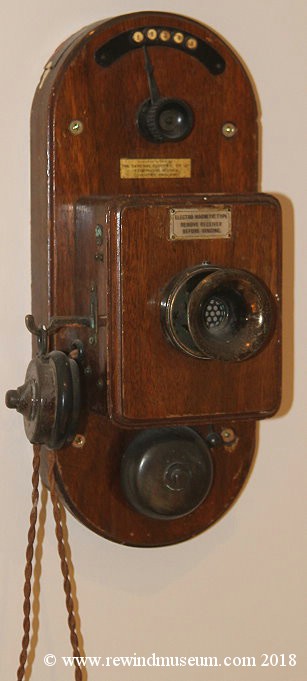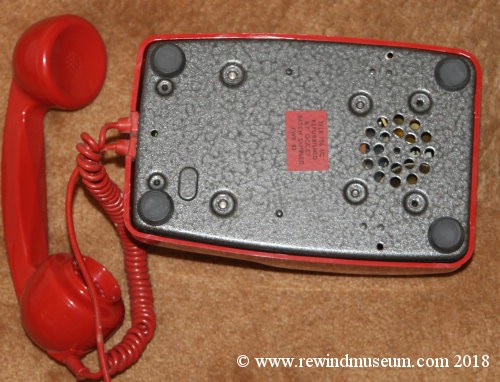Early 1900s. GEC K7867 switch phone.






This phone was purchased in the 2005 as I wanted a phone from the Edwardian days (1901-1910). The phone
was made by the General Electric Company Ltd (GEC) in the UK. I had seen a phone on a program called
"Upstairs Downstairs". This program series was made between 1971 and 1975 but was set between 1903 to 1930

There was an episode in the program when Hudson, the butler, uses this phone and a picture from that episode
is shown above. Since the program was about a family in a large house, the butler used a "switch phone"
also called an "intercommunication telephone" you can see he can switch the call from the servantís area
downstairs to 5 extensions in the family area upstairs. After seeing and remembering this episode, I
found an identical phone and purchased it. There is a button on the right hand side. After selecting
the room from the selector above, the button is pressed and a bell rings in the selected room and
someone then knows they have to pick up that extension. It seems GEC manufactured this phone for
about 30 years, even until 1935 therefore dating this exact unit is difficult. Suffice to say
it was available during the Edwardian period. It is made of solid walnut.
1920s. No 150 Candlestick Phone.





No 150 candlestick telephone with Bakelite No 22 Microphone. This candlestick phone has the later No 22 Bakelite
microphone. It has been in my position since the early 1990s. I bought it from a friend who had worked for BT
all of his life. I paid £100 at the time. I guess it is worth a bit more than that these days but the fact I have
been able to look at it and use it for all of those years is what is important. Included in the price and with
the phone were two bell boxes.


1956. White Bakelite type 300 series phone.






This is a white 1956 Bakelite 312L phone with draw. Originally manufactured and designed by Ericsson in 1932. These
phones were supplied to the GPO and were made for them from 1937-1959. The 312L was introduced in 1949. On the
underside of the handset, embedded into the plastic you can find the date. It says "164 56" so it is 1956. Most
phones were black but white was an option. This meant that less white phones were made and were relatively rare.
There is a story behind how this phone came into my possession -
It was the mid 1980s and a teacher brought two of these phones into a school so that classes could find out
how phones worked. After a while they were given to, what used to be called a "non-exam class". This was a
group of 16 year old children who were not doing any exam work as they were not deemed to be capable of
academic studies. The phones were given to them to take apart and they damaged both of them. They were then
going to be thrown out. I obtained all of the parts and stored them in a box for about 10 years. I then
gave them to a company who built one good phone out of the parts. This is it.

7th July 1966. Two black GPO Model 706L Phones.






One of these two phones is dated 7th July 1966 (top pictures) and so the second phone will be of a similar date.
Notice this type of phone has the numbers outside of the dial. Inside of the dial are pointers. This was the type
of phone most people had in the mid 1960s. Black being the most common colour and with very little choice.
The telephone system in the UK was run by the General Post Office (GPO) nationalised (monopoly) company.
More information below.

1969. Red GPO Model 706 Phones. Pair




I am not sure how long I have had these phones. Could have been since 1990. They are the GPO model 706.
The Telephone No. 706 was first released in 1959 and was advanced for it's day. This is a later 706 as it has
no number ring and all number dial. That means there are no numbers or letters on the ring around the dial,
only within the dial. This makes it 1969. The 706 was manufactured to a GPO design, by several
manufacturers. This pair of red 706s were sold as intercoms and came in a presentation box with cable and
clips (not shown). This is really quite unusual. I have not seen any 706 I/C (intercoms) anywhere else.
Since the sticker on the bottom says BT rather than GPO it seams likely that these 1969 phones were
refurbished GPO old stock and repackaged and sold by BT as intercoms in the 1980s

1967. Two ivory GPO earlier Model 746 Phones.




This is the early version on the model 746 phone. The later version had a recess for the handset to sit in.
Introduced in 1967 this was an improved version of the 706 shown above.
Notice there are only 6 digits to the telephone number in 1967 although in smaller villages there could be less than six.
I can remember a phone number for a property my family owned near Reeth in the UK with 3 digits in 1966
1986. Ivory GPO Model PBT101 Phone.



This is the Plessey PBT100. The 1st Electronic Telephone. It is great to have another first achievement in the museum.
The PBT101 version had the recall button in the highlighted area and so was designated 101. It was an option in the 100 range.
This electronic phone featured fast push-button dialling for the home or the office.
Manufactured by Plessey Communication Systems Limited, Beeston, Nottingham, NG9 1 LA U.K. for "BT" (British Telecom).

 Making a donation.
Making a donation.
The Rewind Museum is a non-profit making endeavour. The web site and the touring exhibitions are run on
a voluntary basis. Donations,
not money, just old items you no longer want, are always welcome.
If you have something that you think would be of interest, please contact us with the details.
We can send in a courier to pick them up. (Even an international courier). Thank you.
Please note - The Rewind Museum site has been archived by the British
Library so that future generations can always access the site's content.
To talk to us about making a donation please go to - "
making a donation".
Are you interested to read about a 10 year + restoration of a classic vehicle?
If so go to -
www.1952chevytruck.com
 The 1952 The 1952 Chevy truck web site.
The 1952 The 1952 Chevy truck web site.

Web site copyright © 2018 Vision International. All rights reserved.
For all questions & comments about this site's content contact Dave at Rewind Museum.







































